An Exchange-Traded Commodity (ETC) is a type of investment vehicle that offers exposure to commodities in a format similar to shares of a company. ETCs are traded on regular stock exchanges, simplifying the process of investing in commodities, which otherwise might require complex futures trading or direct investment in physical assets. For many investors, ETCs are a less risky and less complicated way to tap into the potential profits of commodity trading. They remove the necessity of managing physical goods, storage, and other logistical complications associated with traditional commodity investing. ETCs have democratized commodities investing, allowing regular investors to diversify portfolios and hedge risks, expanding the investment realm. ETCs are structured as debt securities but are collateralized by commodities. A bank or financial institution issues an ETC, which is then backed by an equivalent value of a specific commodity or basket of commodities. This structure allows the ETC to track the price of the commodities closely. The design of ETCs aims to provide a transparent and efficient way for investors to gain exposure to commodity prices without having to engage in futures trading or hold physical assets. ETCs are traded on major stock exchanges just like shares of a company. This provides a high degree of liquidity, enabling investors to buy and sell ETCs during market hours at market prices. This ease of trading can be an attractive feature for investors looking for an investment that allows them to quickly adjust their positions in response to market conditions. The wide accessibility of ETCs on global exchanges also broadens their appeal to a global investor base. Investors need to be aware that while ETCs offer a convenient way to invest in commodities, they also carry unique risks. These include commodity market volatility, potential discrepancies between the ETC price and the underlying commodity price, and counterparty risk if the issuer fails to fulfill its obligations. Therefore, like any other investment, it's essential to thoroughly research and understand the specific ETC you're considering. Investors should closely examine the ETC's prospectus and other relevant documents to fully understand these risks. Gold, silver, platinum, and other precious metals are popular choices for ETCs. These assets are often seen as a hedge against inflation and economic uncertainty. Investors often flock to precious metals during times of market turbulence, making precious metals ETCs a popular choice for portfolio diversification. However, like all investments, precious metals ETCs are not without risks and should be part of a balanced investment strategy. ETCs also provide exposure to energy commodities like oil, natural gas, and coal. These ETCs are affected by factors such as geopolitical events, changes in energy policies, and advancements in renewable energy technologies. As global energy consumption continues to rise and the geopolitical landscape constantly evolves, energy commodity ETCs can provide interesting investment opportunities for those willing to navigate these complex dynamics. Agricultural commodities like corn, wheat, and soybeans can also be accessed through ETCs. Prices of these commodities are influenced by factors such as weather, crop diseases, and shifts in global demand. For those willing to follow and understand the complexities of the agricultural sector, these ETCs can provide a rewarding investment opportunity. ETCs can track the prices of industrial metals such as copper, zinc, and aluminum. These commodities are key to various industries and their prices are influenced by macroeconomic factors and supply-demand dynamics. As the global economy continues to evolve and industrialize, the demand for these metals can offer compelling investment opportunities via ETCs. ETCs provide a simple and accessible way to gain exposure to commodities, an asset class that can provide diversification benefits to an investment portfolio. Given that commodity prices often move independently of equity and bond markets, they can offer an additional layer of diversification. Investing in ETCs therefore allows investors to spread their risk and potentially improve their risk-adjusted returns. Investing directly in commodities can be expensive and complex. ETCs offer a more cost-effective way to access these markets. Since ETCs trade on exchanges, investors can avoid the costs and complications associated with storage, insurance, and transportation that come with holding physical commodities. Unlike direct commodity investments, ETCs are traded on major stock exchanges and can be bought and sold easily. This liquidity means that investors can enter and exit positions quickly, which can be a critical factor during periods of market volatility. Moreover, the trading volumes of ETCs can be quite high, further enhancing their liquidity. Commodities often perform well during periods of inflation. Therefore, ETCs can serve as a useful hedge against inflationary pressures. As the prices of goods and services rise, the price of commodities often increases as well, potentially providing a hedge against the eroding purchasing power of money. Commodity prices can be highly volatile, influenced by a range of global factors such as geopolitical events, economic indicators, weather patterns, and more. For example, energy commodities can be significantly affected by geopolitical tensions in oil-rich regions, while agricultural commodities can fluctuate due to weather events. Investors in ETCs must be prepared for potential price swings. Sometimes, there can be a discrepancy between the price of the ETC and the price of the underlying commodity it represents. This is known as a tracking error. Tracking errors can occur due to a variety of reasons, including the ETC's expenses, changes in the commodity's spot and futures prices, and the methods used by the ETC to track the commodity's price. ETCs are issued by financial institutions. If the issuer fails to fulfill its obligations, the ETC holders could suffer losses. This risk, known as counterparty risk, is important to consider, especially when investing in ETCs from issuers with less solid financial footing. It's important for investors to research the issuer's creditworthiness before investing. The regulatory landscape for ETCs can be complex and varies across jurisdictions. Investors must ensure compliance with all relevant regulations. For example, some jurisdictions may have limitations on the types of investors who can invest in ETCs or the extent of exposure that investors can take on. While both ETCs and ETFs are exchange-traded, ETCs offer exposure to commodities, while ETFs typically track indices, sectors, or a basket of stocks. ETCs can offer a more direct form of commodity exposure, while ETFs provide a broader and more diversified exposure to a sector or market index. The choice between an ETC and an ETF will depend on an investor's specific needs and risk tolerance. Direct commodity investment involves buying and storing physical commodities or trading futures contracts. This can be expensive, complex, and risky. ETCs provide a simpler alternative with fewer logistical challenges. In addition, ETCs allow for exposure to commodity prices without the need to predict futures market movements or manage physical commodities, which can be a significant advantage for many investors. Commodity mutual funds also offer exposure to commodities, but they do so indirectly by investing in companies related to commodities. ETCs, on the other hand, offer direct exposure to commodity prices. Depending on an investor's preferences and risk tolerance, one may be more suitable than the other. As with any investment, diversification is key. Don't put all your eggs in one basket, or in this case, one type of commodity. Consider investing in a mix of different ETCs to spread risk and potentially enhance returns. Diversifying across different types of commodities can help buffer against sector-specific downturns. The commodity market is highly volatile and influenced by a variety of global factors. Regular monitoring of your investments is crucial. This involves not only tracking the prices of your ETCs but also keeping up with news and developments that may affect the underlying commodities. Despite the volatility, having a long-term perspective can help ride out short-term market fluctuations. Commodities can be cyclical, and while prices may fluctuate in the short term, they may follow a general upward trend in the long term due to factors such as inflation and increasing global demand. Understand the factors that drive the price of the commodity that the ETC represents. For instance, if you're considering an ETC that tracks oil, you need to understand factors like global supply and demand dynamics, geopolitical risks, and the potential impact of renewable energy technologies on oil prices. Evaluate the financial health and reputation of the issuer. The issuer's creditworthiness can significantly affect the ETC's risks and returns. Therefore, it's important to research the issuer's financial stability and track record in managing ETCs. Investors must fully understand the unique risks associated with ETCs. This includes not only the risks associated with the specific commodity but also the risks inherent in the structure of ETCs, such as tracking errors and counterparty risk. Consider how ETCs fit into the larger picture of portfolio diversification and risk management. ETCs can provide an additional layer of diversification, but they should be used as part of a well-balanced portfolio that includes other assets, such as equities and bonds. Exchange-Traded Commodities (ETCs) offer a convenient and accessible way to gain exposure to the commodities market. They democratize the asset class, allowing investors to diversify portfolios, hedge risks, and tap into potential profits from various commodities, including precious metals, energy commodities, agricultural commodities, and industrial metals. ETCs simplify commodity investments by removing complex futures trading and direct investment in physical assets, reducing logistics and risk management complexities. However, they come with unique risks, such as market volatility, tracking errors, and counterparty risk. Thus, careful examination of the ETC's prospectus and understanding the inherent risks is crucial. Compared to other investment options like ETFs, direct commodity investments, and mutual funds, ETCs provide direct exposure to commodities. Therefore, the choice between ETCs and other investments depends largely on an investor's specific needs and risk tolerance. Investors should consider diversification, regular monitoring, and a long-term perspective as best practices when investing in ETCs.What Is an Exchange-Traded Commodity (ETC)?
Functioning of an ETC
Formation and Structure
Trading and Liquidity
Risk Management
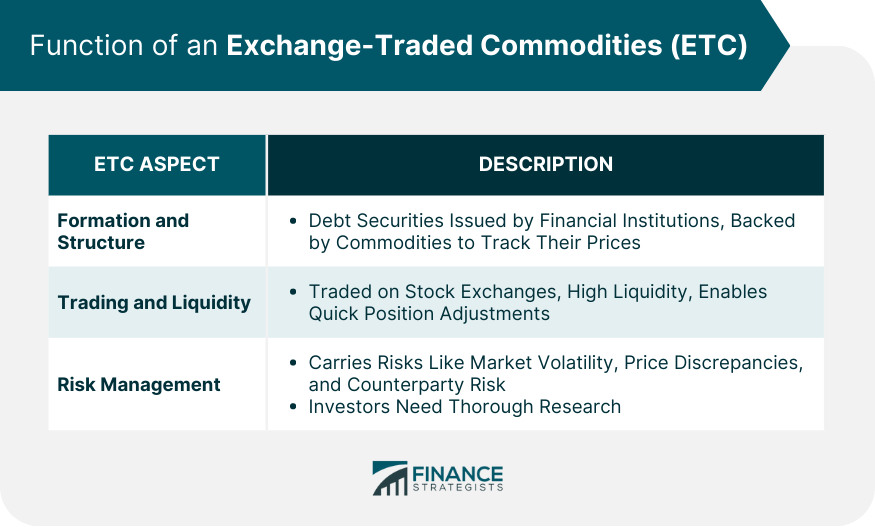
Diverse Commodity Classes in ETC
Precious Metals
Energy Commodities
Agricultural Commodities
Industrial Metals
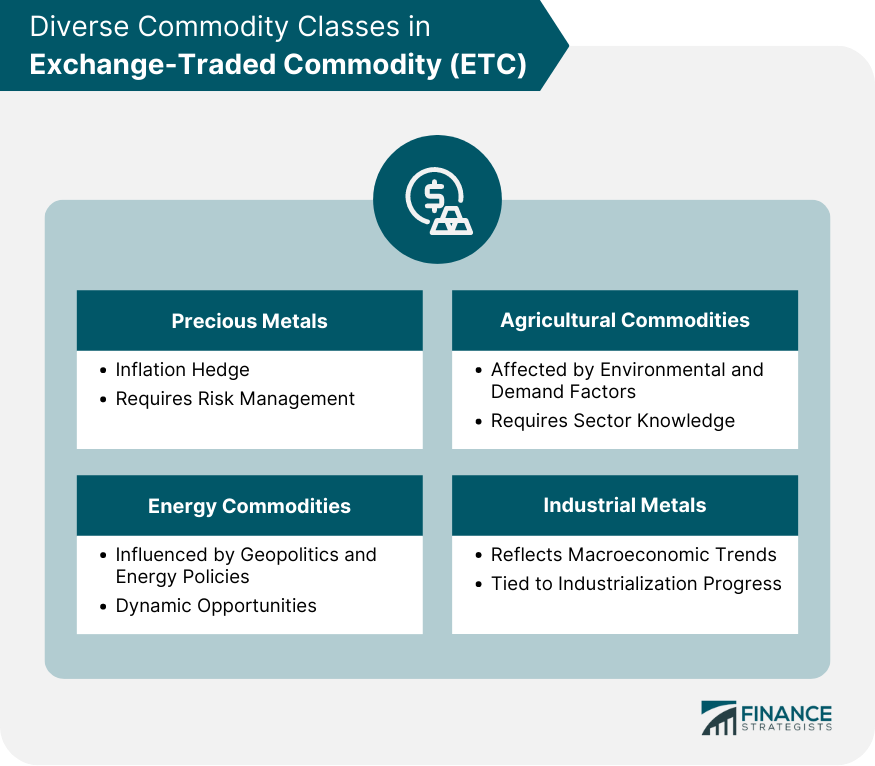
Benefits of Investing in ETCs
Accessibility and Diversification
Cost Effectiveness
Liquidity
Hedging Against Inflation
Drawbacks of ETCs
Commodity Market Volatility
Tracking Errors
Counterparty Risk
Regulatory Challenges
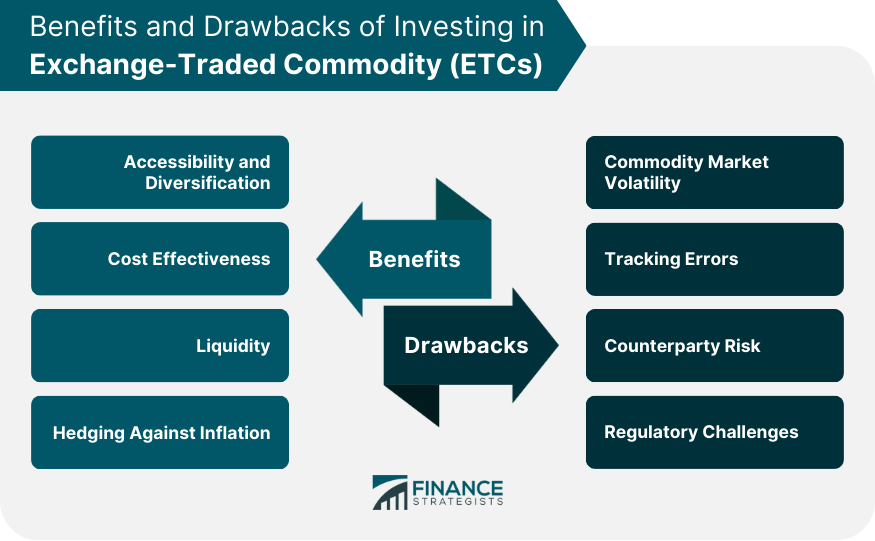
ETC vs Other Investment Options
ETC vs ETF
ETC vs Direct Commodity Investment
ETC vs Mutual Funds
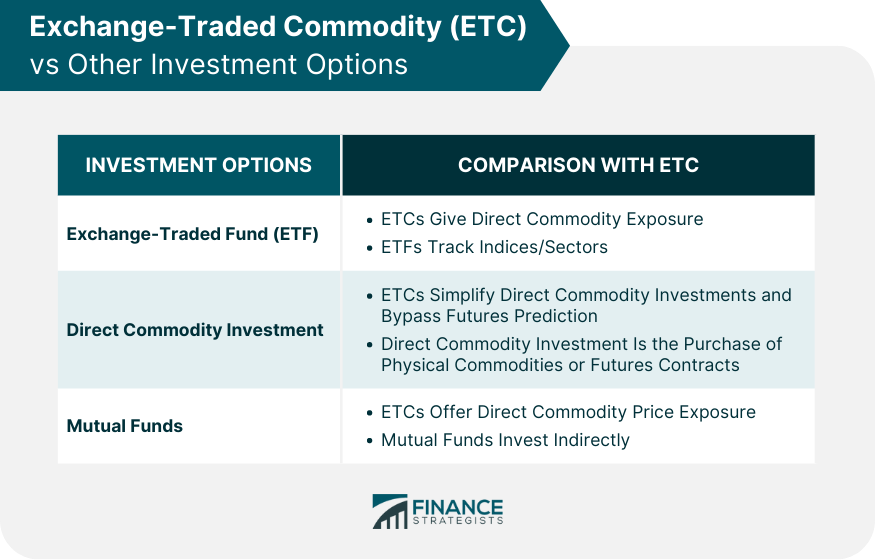
Best Practices for Investing in ETCs
Diversification
Regular Monitoring
Long-Term Perspective
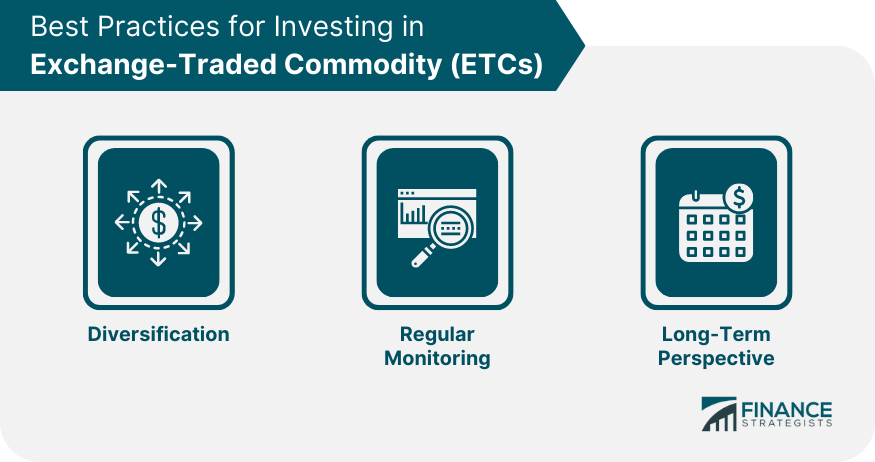
Key Considerations for ETC Investment
Assessing the Underlying Commodity
Evaluating ETC Issuer
Understanding the Risks
Role of ETCs in Portfolio Diversification
Final Thoughts
Exchange-Traded Commodity (ETC) FAQs
An ETC is an investment vehicle that provides exposure to commodities, trading on stock exchanges like company shares.
ETCs offer a cost-effective, liquid, and accessible way to gain exposure to commodities, allowing portfolio diversification and hedging against inflation.
ETCs come with risks such as commodity market volatility, tracking errors, counterparty risk, and regulatory challenges.
ETCs provide direct exposure to commodity prices, unlike ETFs, which track indices or sectors, and commodity mutual funds, which invest in related companies.
Successful ETC investment strategies involve diversification across different commodities, regular monitoring of investments, and maintaining a long-term perspective.
True Tamplin is a published author, public speaker, CEO of UpDigital, and founder of Finance Strategists.
True is a Certified Educator in Personal Finance (CEPF®), author of The Handy Financial Ratios Guide, a member of the Society for Advancing Business Editing and Writing, contributes to his financial education site, Finance Strategists, and has spoken to various financial communities such as the CFA Institute, as well as university students like his Alma mater, Biola University, where he received a bachelor of science in business and data analytics.
To learn more about True, visit his personal website or view his author profiles on Amazon, Nasdaq and Forbes.











